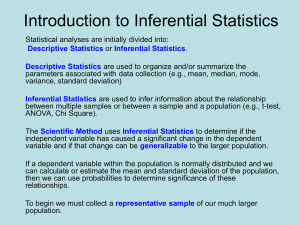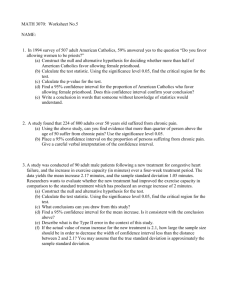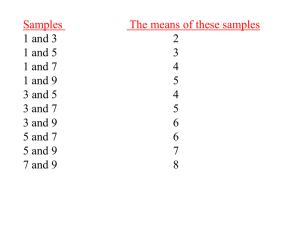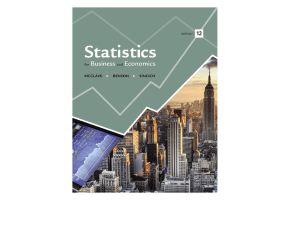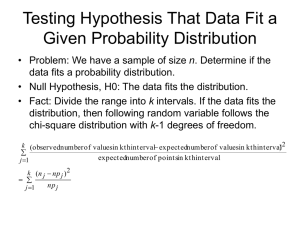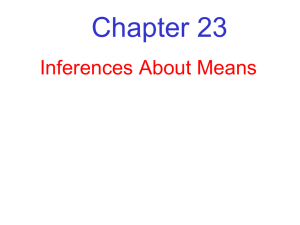Marketing Exam Sample Questions - MKTG 3710
advertisement
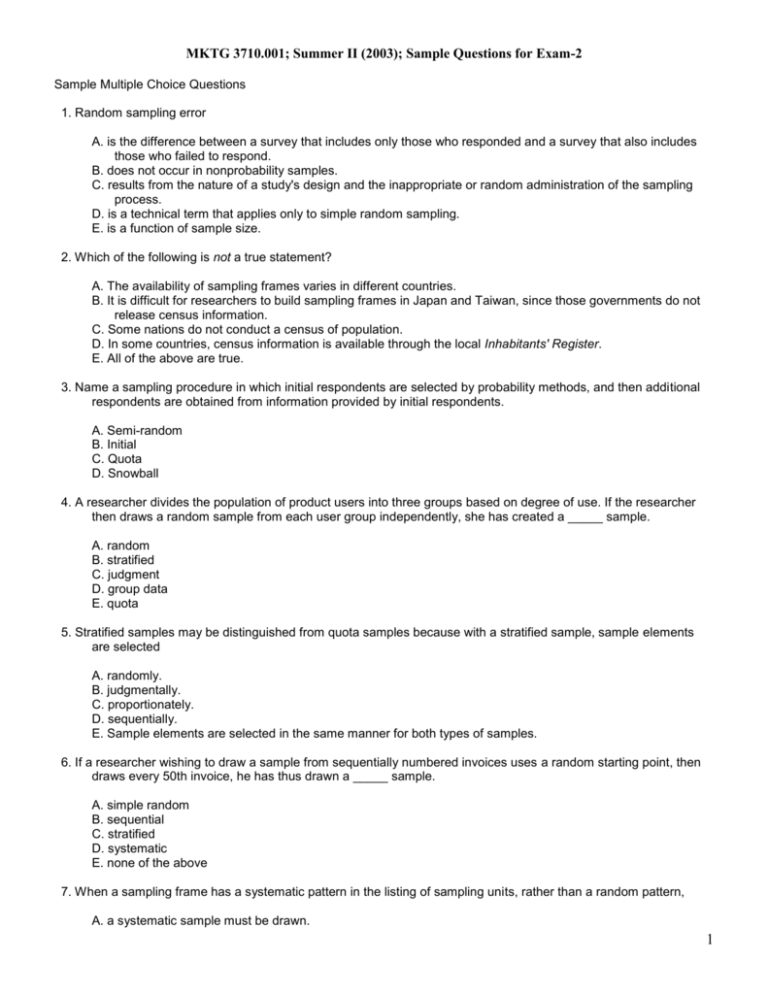
MKTG 3710.001; Summer II (2003); Sample Questions for Exam-2 Sample Multiple Choice Questions 1. Random sampling error A. is the difference between a survey that includes only those who responded and a survey that also includes those who failed to respond. B. does not occur in nonprobability samples. C. results from the nature of a study's design and the inappropriate or random administration of the sampling process. D. is a technical term that applies only to simple random sampling. E. is a function of sample size. 2. Which of the following is not a true statement? A. The availability of sampling frames varies in different countries. B. It is difficult for researchers to build sampling frames in Japan and Taiwan, since those governments do not release census information. C. Some nations do not conduct a census of population. D. In some countries, census information is available through the local Inhabitants' Register. E. All of the above are true. 3. Name a sampling procedure in which initial respondents are selected by probability methods, and then additional respondents are obtained from information provided by initial respondents. A. Semi-random B. Initial C. Quota D. Snowball 4. A researcher divides the population of product users into three groups based on degree of use. If the researcher then draws a random sample from each user group independently, she has created a _____ sample. A. random B. stratified C. judgment D. group data E. quota 5. Stratified samples may be distinguished from quota samples because with a stratified sample, sample elements are selected A. randomly. B. judgmentally. C. proportionately. D. sequentially. E. Sample elements are selected in the same manner for both types of samples. 6. If a researcher wishing to draw a sample from sequentially numbered invoices uses a random starting point, then draws every 50th invoice, he has thus drawn a _____ sample. A. simple random B. sequential C. stratified D. systematic E. none of the above 7. When a sampling frame has a systematic pattern in the listing of sampling units, rather than a random pattern, A. a systematic sample must be drawn. 1 MKTG 3710.001; Summer II (2003); Sample Questions for Exam-2 B. the problem of periodicity exists. C. a random error occurs. D. a cluster sample must be used. E. a sampling frame error occurs. 8. Suppose a researcher is concerned with a nominal scale that identifies users versus nonusers of bank credit cards. The measure of central tendency appropriate to this scale is the A. mean. B. median. C. mode. D. average. E. range. 9. The variance A. is a poor index of the degree of dispersion. B. has a major drawback because it reflects a unit of measurement that has been squared. C. is the squared root of the standard deviation. D. is the average deviation squared. 10. The formula µ = A. B. C. D. ± a sampling error expresses the idea of the cetral limit theorem. Expresses the idea of the confidence interval. Expresses the idea that a sample frame is not a perfect representation of the population. None of the above. 11. Which of the following is not needed in calculating a confidence interval for a population mean? A. a point estimate of the population mean B. an estimate of the population variance C. a confidence level D. All of the above are needed. E. None of the above is needed. 12. A specific range of numbers within which a population mean should lie is A. the range. B. the confidence coefficient. C. the confidence interval. D. the confidence level. 13. Which of the following factors is not necessary in determining sample size? A. estimated standard deviation of the population B. magnitude of acceptable error C. confidence level D. All of the above are necessary. 14. Constructing a frequency distribution A. is one of the most common means of summarizing data. B. begins by recording the number of times a particular value occurs. C. is the basis for construction of a percentage distribution. D. all of the above E. none of the above 15. If you wish to estimate the mean of a particular population, doubling the range of acceptable error will reduce sample size to _____ its original size. 2 MKTG 3710.001; Summer II (2003); Sample Questions for Exam-2 A. one-half. B. one-fourth. C. twice. D. It cannot be determined. E. There is no relationship between changes in sample size and changes in acceptable error. 16. Before a confidence interval can be constructed around a sample proportion A. the sample mean must be calculated. B. an estimate of the standard error of the proportion (Sp) must be calculated. C. the standard error of the mean is divided by the square root of n. D. none of the above 17. The confidence interval for a proportion uses the following formula: A. P ± Zc.l.SP B. SP ± ZP C. XTO(X) ± ZSX D. none of the above 18. Calculate the sample standard deviation using the following data: X 4 5 2 6 4 3 4 The standard deviation is which of the following? A. 10 B. 1.66 C. 1.20 D. 1 E. 0 19. Using the standardized normal table supplied with this exam determine what Z value would be used to set up a confidence interval at the 99 percent confidence level. A. .01 B. 1.01 C. 1.65 D. 1.96 E. 2.57 20. Using the standardized normal table supplied with this exam determine what Z value would be used to set up a confidence interval at the 95 percent confidence level. A. .05 B. 1.05 C. 1.65 D. 1.96 E. 2.57 21. The standard deviation 3 MKTG 3710.001; Summer II (2003); Sample Questions for Exam-2 A. is the most valuable measure of spread or dispersion. B. does not have the limitations of the average deviation. C. does not have the drawbacks of the variance because its unit of measure is not squared, but is in the same unit of measure as the mean. D. all of the above E. none of the above 22. The practical result of the central limit theorem is that A. researchers must take a large number of samples before inferences about the population can be made. B. the researcher must know the shape of the population distribution before inferences about the population can be made. C. small-sized samples should not be used in research. D. the concept of the sampling distribution is unimportant to researchers. E. none of the above 23. A frequency distribution (or probability distribution) of all possible values of sample means for a sample size of 200 is the A. population distribution. B. sample distribution. C. sampling distribution. D. standard normal distribution. 24. The formula Z = (X - µ)/σ where µ is the hypothesized or expected value of the mean, is A. B. C. D. the formula for a confidence interval. The way of making a linear transformation of any normal variable into a standard normal variable. The formula for calculating the standard error of the mean. The computation for estimating the value of the central limit theorem. 25. A _____ distribution is a theoretical probability distribution that shows the functional relationship between the possible values of some summary characteristic of n cases drawn at random and the probability (density) associated with each value over all possible samples of size n from a particular population. A. population B. sample C. sampling D. standardized normal 26. Which of the following is not a step in calculation of the chi-square statistic? A. Formulate the null hypothesis and determine the expected frequency of each answer. B. Determine the appropriate significance level. C. Calculate the sample mean. D. Calculate the chi-square value. 27. Hypothesis tests are designed so that the _____ hypothesis will be rejected. A. null B. alternative C. incorrect D. alpha E. beta 28. If you wanted to display graphically the relationship of one variable to another, you might use a: A. Pie chart. B. Table. 4 MKTG 3710.001; Summer II (2003); Sample Questions for Exam-2 C. Line graph. D. Data matrix. E. Computer program such as SPSS. 29. In a contingency table, row and column totals are often called A. simple tabulations. B. cells. C. marginals. D. boxheads and stubheads respectively. 30. The process of changing the original form of the data to a format suitable to perform a data analysis is A. cheating B. formatting C. data transformation D. normalization E. none of the above 31. In a percentage cross-tabulation the total number of respondents or observations may be used as a(n) _____ for computing the percentage in each cell. A. index B. base C. centroid D. cell total 32. In a percentage cross-tabulation, the conventional rule for determining the direction of the percentages (if the researcher has identified the independent and dependent variables) is to A. compute the percentages in the direction of the independent variable. B. compute the percentages in the direction of the dependent variable. C. perform an elaboration analysis. D. none of the above (there is no conventional rule.) 33. A _____ variable is a third variable that, when introduced into a cross-tabulation analysis, alters or has a contingent effect on the relationship between an independent and a dependent variable. A. matrix B. moderator C. categorical D. marginal 34. Which of the following statements about descriptive analysis is false? A. For most projects, statistical analysis begins by reducing the raw data into a summary format. B. Tabulation refers to the orderly arrangement of data in a table or other summary format. C. Analyzing results by groups or categories is the technique of tabulation. D. A frequency table is the arrangement of statistical data in a row and column format. 35. Regarding the difference between two groups when comparing proportions, _____ is the appropriate criterion for selecting either a t-test or a Z-test. A. Value of the population standard deviation B. Degrees of freedom C. The coefficient of determination D. Sample size E. None of the above 36. When testing the difference between two proportions, the null hypothesis is usually that 5 MKTG 3710.001; Summer II (2003); Sample Questions for Exam-2 A. proportion 1 is greater than proportion 2. B. the population proportions are unequal. C. the population proportions are equal. D. the pooled proportion equals the pooled variance. E. None of the above is an appropriate null hypothesis. 37. When there are three levels of an independent variable, the null hypothesis is that A. the sum of the means is a minimum value. B. mean 1 > mean 2 > mean 3. C. the means are all unequal to each other. D. the means are all equal. E. A null hypothesis cannot be stated for three levels of an independent variable. 38. In the application of chi-square analysis, if the calculated chi-square value is larger than the tabular chi-square value, the researcher should A. check for a math error. B. accept the null hypothesis. C. reject the null hypothesis. D. use a different technique since chi-square is inappropriate. E. multiply by n, the sample size. 39. When using the chi-square analysis in bivariate problems, degrees of freedom are calculated as (R=row and C=column) A. (R - 1)(C - 1). B. R x C + 1. C. (R + 1)(C + 1). D. R + (C - 1). E. none of the above 40. Adding additional independent variables in a regression equation will A. increase the value of the coefficient of multiple determination. B. improve the predictive power of the equation. C. reduce the predictive power of the equation. D. Additional independent variables may not be added to a regression equation. E. none of the above 6 MKTG 3710.001; Summer II (2003); Sample Questions for Exam-2 ANSWER KEY FOR TEST - UNTITLED 1. E 2. B 3. D 4. B 5. A 6. D 7. B 8. C 9. B 10. B Chapter:12 Chapter:12 Chapter:12 Chapter:12 Chapter:12 Chapter:12 Chapter:12 Chapter:13 Chapter:13 Chapter:13 QUESTION: 53 QUESTION: 63 QUESTION: 68 QUESTION: 69 QUESTION: 72 QUESTION: 73 QUESTION: 74 QUESTION: 64 QUESTION: 67 QUESTION: 68 11. D 12. C 13. D 14. D 15. B 16. B 17. A 18. C 19. E 20. D Chapter:13 Chapter:13 Chapter:13 Chapter:13 Chapter:13 Chapter:13 Chapter:13 Chapter:13 Chapter:13 Chapter:13 QUESTION: 70 QUESTION: 71 QUESTION: 75 QUESTION: 76 QUESTION: 82 QUESTION: 84 QUESTION: 85 QUESTION: 88 QUESTION: 91 QUESTION: 92 21. D 22. E 23. C 24. B 25. C 26. C 27. A 28. C 29. C 30. C Chapter:13 Chapter:13 Chapter:13 Chapter:13 Chapter:13 Chapter:14 Chapter:14 Chapter:14 Chapter:14 Chapter:14 QUESTION:100 QUESTION:108 QUESTION:110 QUESTION:112 QUESTION:113 QUESTION: 40 QUESTION: 42 QUESTION: 45 QUESTION: 47 QUESTION: 50 31. B 32. A 33. B 34. C 35. D 36. C 37. D 38. C 39. A 40. A Chapter:14 Chapter:14 Chapter:14 Chapter:14 Chapter:15 Chapter:15 Chapter:15 Chapter:15 Chapter:15 Chapter:15 QUESTION: 53 QUESTION: 54 QUESTION: 56 QUESTION: 59 QUESTION: 26 QUESTION: 31 QUESTION: 32 QUESTION: 40 QUESTION: 41 QUESTION: 44 7

